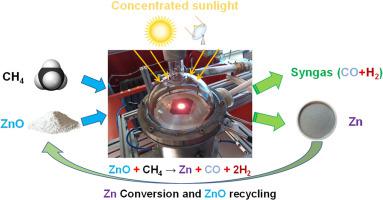当前位置:
X-MOL 学术
›
Fuel Process. Technol.
›
论文详情
Our official English website, www.x-mol.net, welcomes your
feedback! (Note: you will need to create a separate account there.)
Combined ZnO reduction and methane reforming for co-production of pure Zn and syngas in a prototype solar thermochemical reactor
Fuel Processing Technology ( IF 7.2 ) Pub Date : 2021-01-01 , DOI: 10.1016/j.fuproc.2020.106572 Srirat Chuayboon , Stéphane Abanades
Fuel Processing Technology ( IF 7.2 ) Pub Date : 2021-01-01 , DOI: 10.1016/j.fuproc.2020.106572 Srirat Chuayboon , Stéphane Abanades

|
Abstract Solar thermochemical conversion processes offer a promising avenue for storing intermittent solar energy into high value chemical products. A directly-irradiated packed-bed reactor was developed to experimentally investigate the solar thermochemical methane reforming combined with ZnO reduction for co-production of Zn and syngas in a single process. On-sun experiments were conducted to demonstrate reliable process operation and to identify optimal operating conditions, considering the impact of reduced and atmospheric pressures, temperatures, and inlet methane flow-rates. A pressure decrease enhanced net ZnO conversion at the expense of lowered syngas selectivity attributed to the CO2 increase because of insufficient gas residence time. Increasing temperature promoted syngas production rate, yield, ZnO and methane conversion at the expense of favored methane cracking which can be alleviated by lowering pressure. The maximum H2 and CO yields of 28.4 and 4.6 mmol/gZnO, and the maximum net ZnO conversion and methane conversion (67.3% and 57.6%) were achieved from non-isothermal tests. The calorific value of chemical products was upgraded by solar energy (U up to 1.31), and ηsolar-to-chemical = 3.9% was achieved. Pure and highly reactive metallic Zn was produced with well crystallized structure in micrometric size, demonstrating the feasibility of combined solar methane reforming and ZnO reduction for synthetic fuel production and sustainable Zn metallurgy.
中文翻译:

结合 ZnO 还原和甲烷重整,在原型太阳能热化学反应器中联产纯 Zn 和合成气
摘要 太阳能热化学转化过程为将间歇性太阳能储存为高价值化学产品提供了一种有前途的途径。开发了一种直接照射的填充床反应器,以实验研究太阳能热化学甲烷重整与 ZnO 还原相结合,以在单个过程中联产 Zn 和合成气。考虑到减压和大气压力、温度和入口甲烷流速的影响,进行了日照实验以证明可靠的工艺操作并确定最佳操作条件。压力降低提高了净 ZnO 转化率,但代价是合成气选择性降低,这是由于气体停留时间不足导致 CO2 增加。升高温度促进了合成气的产率、收率、ZnO 和甲烷转化以有利的甲烷裂解为代价,这可以通过降低压力来缓解。非等温测试获得的最大 H2 和 CO 产量分别为 28.4 和 4.6 mmol/gZnO,以及最大的净 ZnO 转化率和甲烷转化率(67.3% 和 57.6%)。化工产品热值通过太阳能升级(U高达1.31),ηsolar-to-chemical = 3.9%。生产出具有微米级结晶结构的纯且高反应性的金属锌,证明了太阳能甲烷重整和氧化锌还原相结合用于合成燃料生产和可持续锌冶金的可行性。非等温测试实现了最大的净 ZnO 转化率和甲烷转化率(67.3% 和 57.6%)。化工产品热值通过太阳能升级(U高达1.31),ηsolar-to-chemical = 3.9%。生产出具有微米级结晶结构的纯且高反应性的金属锌,证明了太阳能甲烷重整和氧化锌还原相结合用于合成燃料生产和可持续锌冶金的可行性。非等温测试实现了最大的净 ZnO 转化率和甲烷转化率(67.3% 和 57.6%)。化工产品热值通过太阳能升级(U高达1.31),ηsolar-to-chemical = 3.9%。生产出具有微米级结晶结构的纯且高反应性的金属锌,证明了太阳能甲烷重整和氧化锌还原相结合用于合成燃料生产和可持续锌冶金的可行性。
更新日期:2021-01-01
中文翻译:

结合 ZnO 还原和甲烷重整,在原型太阳能热化学反应器中联产纯 Zn 和合成气
摘要 太阳能热化学转化过程为将间歇性太阳能储存为高价值化学产品提供了一种有前途的途径。开发了一种直接照射的填充床反应器,以实验研究太阳能热化学甲烷重整与 ZnO 还原相结合,以在单个过程中联产 Zn 和合成气。考虑到减压和大气压力、温度和入口甲烷流速的影响,进行了日照实验以证明可靠的工艺操作并确定最佳操作条件。压力降低提高了净 ZnO 转化率,但代价是合成气选择性降低,这是由于气体停留时间不足导致 CO2 增加。升高温度促进了合成气的产率、收率、ZnO 和甲烷转化以有利的甲烷裂解为代价,这可以通过降低压力来缓解。非等温测试获得的最大 H2 和 CO 产量分别为 28.4 和 4.6 mmol/gZnO,以及最大的净 ZnO 转化率和甲烷转化率(67.3% 和 57.6%)。化工产品热值通过太阳能升级(U高达1.31),ηsolar-to-chemical = 3.9%。生产出具有微米级结晶结构的纯且高反应性的金属锌,证明了太阳能甲烷重整和氧化锌还原相结合用于合成燃料生产和可持续锌冶金的可行性。非等温测试实现了最大的净 ZnO 转化率和甲烷转化率(67.3% 和 57.6%)。化工产品热值通过太阳能升级(U高达1.31),ηsolar-to-chemical = 3.9%。生产出具有微米级结晶结构的纯且高反应性的金属锌,证明了太阳能甲烷重整和氧化锌还原相结合用于合成燃料生产和可持续锌冶金的可行性。非等温测试实现了最大的净 ZnO 转化率和甲烷转化率(67.3% 和 57.6%)。化工产品热值通过太阳能升级(U高达1.31),ηsolar-to-chemical = 3.9%。生产出具有微米级结晶结构的纯且高反应性的金属锌,证明了太阳能甲烷重整和氧化锌还原相结合用于合成燃料生产和可持续锌冶金的可行性。











































 京公网安备 11010802027423号
京公网安备 11010802027423号